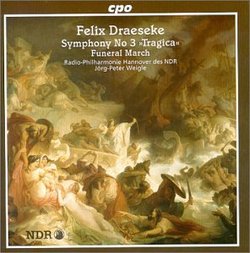| All Artists: Felix Draeseke, Jorg-Peter Weigle, Hannover Radio Symphony Orchestra Title: Felix Draeseke: Symphony 3/Funeral March Members Wishing: 0 Total Copies: 0 Label: Cpo Records Release Date: 6/13/2000 Genres: Special Interest, Classical Styles: Marches, Symphonies Number of Discs: 1 SwapaCD Credits: 1 UPC: 761203958122 |
Search - Felix Draeseke, Jorg-Peter Weigle, Hannover Radio Symphony Orchestra :: Felix Draeseke: Symphony 3/Funeral March
 | Felix Draeseke, Jorg-Peter Weigle, Hannover Radio Symphony Orchestra Felix Draeseke: Symphony 3/Funeral March Genres: Special Interest, Classical
|
Larger Image |
CD DetailsSimilar CDs
|
CD ReviewsUnknown Symphonic Masterpiece A K Howe | Clacton-on-Sea, England | 08/06/2004 (4 out of 5 stars) "Draeseke's 'Tragica' is quite simply an unknown symphonic masterpiece by an unknown master-composer. What is so fascinating about Draeseke (1835-1913) is that he forged an idiom which synthesizes the 'New German' music of Liszt and Wagner with the traditional classicism of Beethoven, Brahms, etc. Brahms himself thought Draeseke to be his most formidable rival, but history, sadly, has forgotten him. The 'Tragica', although (like all music) containing reminiscences of other composers, is very much echt-Draeseke. Quite simply, no-one else could have composed this noble, visionary symphony. And the performance by Weigle and his radio orchestra is very good indeed - much the best of the recordings that have been available. It is alert, captures the passion and nobility of the piece and is also beautifully recorded. All that we need now is for a world-class conductor and orchestra to take on the 'Tragica'. For example, Mariss Jansons and his Bavarian orchestra would be perfect for this repertoire. In the meantime, CPO are to be congratulated on promoting this wonderful music by a great composer still largely waiting to be discovered. " Mr. Raff, Mr. Pfitzner, Meet Mr. Draeseke Thomas F. Bertonneau | Oswego, NY United States | 10/16/2000 (4 out of 5 stars) "Who in the blazes was Felix Draeseke? Decades ago, in the Dark Ages of the long-playing record, a classical music outfit improbably named Varèse-Sarabande (they're still around) issued an antique, most likely wartime, recording of Draeseke's (1835-1913) Third Symphony, Opus 40, in C, the "Symphonia Tragica" (1886). I bought the record, not because I had the faintest inkling about the composer but because the slip-cover sported an acrylic by Ron Miller, the astronomical artist: It showed a primordial moon rising over the horizon of a still-molten earth. Very dramatic. Close to sublime. Yet how this concerned the music, I haven't (once again) even the faintest notion. Legend narrates that in his lifetime, Draeseke occupied a niche among musical reputations close to that of Brahms. (So, of course, did Raff and Rheinberger.) Critics supposedly ranked the "Symphonia Tragica" among the exalted instances of its genre, and, in the 1940s, Wilhelm Furtwängler allegedly planned to reintroduce it in the repertory. (Somehow Goebbels found Draeseke congenial, however, causing Furtwängler to drop his plans.) Is the fuss justified? It depends how one phrases the question. If we're on guard for the equal of Brahms' C-Minor Symphony, then observers might excuse our mild disappointment. If we're hunting for neglected scores of true seriousness, then third parties might well note our interest and seek to share in the merit of its object. For no one can doubt that Draeseke's C-Major Symphony springs from the purest water of Teutonic earnestness. The slow introduction (Andante) to the First Movement proper (Allegro Risoluto) expands on the old Haydn-pattern: Of note is a horn-call which one knows that the composer will mine in the development; also important is the march-like subject for full orchestra, highly reminiscent of Raff (the "Lenore" Symphony) - this too will assume importance in the working-out. The Second Movement (Adagio Ma Non Troppo), a funeral march, forecasts something of what Mahler would do with the obsequious procession; in some passages, a cultivated listener might also think proleptically of Elgar. Next comes the Scherzo (Allegro, Molto Vivace): Here, as with so many Germanic symphonies of the period, Draeseke finds his model in Mendelssohn, but he lacks Mendelssohn's deft touch. It strikes me as a bit incongruous, considering what has come before, but qualifies as effective in its own terms, especially in the horn-dominated trio, which has a more serious character than the rest. (I might use exactly the same words to describe the Scherzo of Pfitzner's C-Sharp Minor Symphony [1931, based on a String Quartet of 1925], a backward-looking score that seems nearer in time to Draeseke's "Tragica" than it really is; in spirit, however, one must admit that the two compositions are perfectly contemporary.) The Fourth Movement (Allegro Con Brio) recalls material from the previous three movements while launching new, summary, themes of its own. How like the Finale of Raff's Fifth (ca. 1875), one might blurt out! Yet in revisiting the horn-call, for instance, from the First Movement, or certain choreographic figures from the Scherzo, Draeseke does seem to infuse the material with a renewed and heightened significance. It's not noticeably "tragic," and I experienced no visions of a primordial moon rising above the horizon of a still-molten earth, but I confess to having enjoyed it. I also suspect that I will listen to it again, more than once, with continued pleasure. Maestro Jörg-Peter Weigle also leads the Radio-Philharmonie Hannover des NDR in Draeseke's Funeral March, Opus 79, in E-Minor, dedicated to "German soldiers who fell in battle in Africa." This refers presumably to Kaiser Bill's colonial expeditions, under General von Trotha, in Southwest Africa at the turn of the century. Not a "must," but not to be regretted either." An underrated late romantic symphony modeled on Wagner Larry VanDeSande | Mason, Michigan United States | 03/07/2009 (5 out of 5 stars) "German Felix Draeseke (1835-1913) wrote a trio of numbered symphonies as well as a Symphony No. 0. The numbered symphonies have all been recorded by CPO in the last decade or so. By general consensus, critics and musicologists believe his Symphony No. 3, inappropriately named "Symphonia tragica", is his greatest symphony and perhaps his greatest work.
Even though Draeseke was an admirer of Wagner and Liszt, this opus, like his Symphony No. 1, begins with ill-tempered timpani thwacks remindful of Beethoven. The music soon turns more high than late romantic, bringing to mind Mendelssohn and Schumann rather than Liszt and Wagner. It is followed by an Eroica-like adagio marked Grave where the imprint of Beethoven is still great. A delightfully Mendelssohnian scherzo follows that leads to a sweet allegro with strings leading woodwinds and brass. This gravitates to a jaunty ending. The finale begins with more Mendelssohnian felicitousness that turns late to an extrememly powerful Wagnerian interlude before ending quietly, as if the dramatic circuit this music makes is completely realized and now can be laid to rest. I'd never heard this music before I bought this recording and took a flyer on all three of Draeseke's symphonies. The Symphonies Nos. 1 and 4 were, by my reckoning, derivative and forgettable. Especially in Symphony 1, Draeseke was the secondary voice of Schubert. This concluding symphony of his ouevre is another matter altogether; here is no doubt a dramatic masterpiece of contrapuntal design, orchestratiion, timing and pace, all beautifully realized by the forces employed here, the Radio Philharmonic Orchestra of Hanover and conductor Jorg-Peter Weigle, who has recorded all three of Draeseke's numbered symphonies for CPO. What I found curious about this interpretation was Weigle. He conducts the score as if it were the Mendelssohn Symphony 6 rather than Bruckner, Liszt or Wagner even though he had a chance to do that, especially in the more riveting moments of the finale. He held back throughout the proceedings, however, and played the score as if it were a middle 1800s creation. I haven't heard the other recording of this music, by the Symphony Orchestra Wuppertal under George Hanson, and I'd be curious to hear if he moves it more in a late romantic direction. This recording, made in 1997-98 in Hannover and released in 2000, was said to be the first CD recording of the music. The lengthy notes are full of history and suggest the Symphonia tragica was on the bill of Germany's greatest conductors through the 1920s, before the Nazis apparently used Draeseke as a model national socialist composer. Even Furtwangler, say the notes, played this symphony in concert. This recording, going on 10 years old now, was well-received everywhere when it came out and rightly so. It is exceptionally well-played and recorded, with vivid clarity and fine detail throughout. I've read critics that put it on their best of year lists. The one thing I don't hear in this interpretation, however, is tragedy. This is an up tempo, upbeat performance, mostly in major key. The Funeral march that accompanies it on the recording is quite tragic, by contrast, and ends in a flurry of romantic tragedy. So at least you get some on the recording." |

 Track Listings (5) - Disc #1
Track Listings (5) - Disc #1

